ECO mode Citroen C4 DAG 2014.5 2.G Owner's Guide
[x] Cancel search | Manufacturer: CITROEN, Model Year: 2014.5, Model line: C4 DAG, Model: Citroen C4 DAG 2014.5 2.GPages: 340, PDF Size: 12.89 MB
Page 138 of 340

99
136
C4-2_en_Chap09_conduite_ed01-2014
Key left in the "Ignition on"
position
On
opening
the
driver's
door
,
an
alert
message
is
displayed,
ac
-
companied
by
an
audible
signal,
to
remind
you
that
the
key
is
still
in
the
ignition
switch
at
posi
-
tion
1 (Stop).
If
the
key
has
been
left
in
the
igni
-
tion switch at position 2 (Ignition
on),
the
ignition
will
be
switched
of
f automatically after one hour.
To
switch
the
ignition
back
on,
turn
the
key
to
position
1 (Stop)
,
then
back
to
position
2 (Ignition
on)
.Switching off the engine
F Stop the vehicle.
F
With
the
engine
running
at
idle,
turn
the
key to position 1.
F
Remove
the
key
from
the
ignition
switch.
F
T
o
lock
the
steering
column,
turn
the
steering
until it locks. Energy economy mode
After
switching of f the engine (posi -
tion 1-Stop ), for a maximum of 30 min -
utes you can still use functions such
as
the
audio
and
telematic
system,
the
wipers,
dipped
beam
headlamps,
cour
-
tesy
lamps, ...
For
more
information,
refer
to
the
"Practical
information"
sec
-
tion,
under
"Energy
economy
mode".
T
o
facilitate
unlocking
of
the
steer
-
ing
column,
it
is
recommended that
the
wheels
be
returned
to the
straight
ahead
position
before switching
off the engine.
F
Check
that
the
parking
brake
is
cor
-
rectly
applied,
particularly
on
sloping ground.Never
switch
of
f
the
ignition
be
-
fore
the
vehicle
is
at
a
complete
stop.
With
the
engine
of
f,
the
braking
and
steering
assistance
systems
are
also
cut
of
f:
risk
of
loss
of control of the vehicle.
When you leave the vehicle,
keep
the
key
with
you
and
lock
the
vehicle.
DRIVING
Page 139 of 340
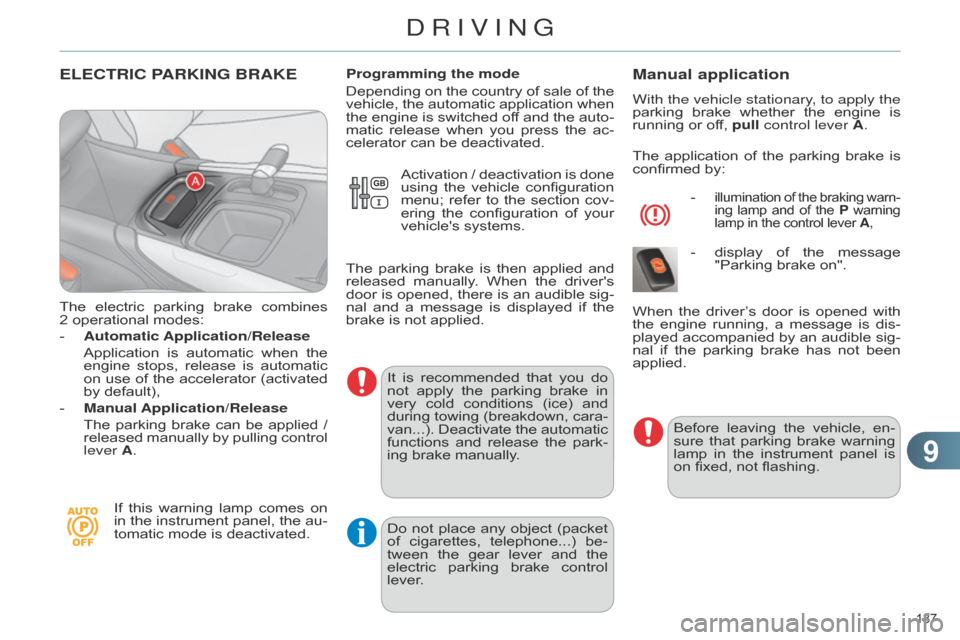
99
137
C4-2_en_Chap09_conduite_ed01-2014
ELECTRIC PARKING BRAKE
The electric parking brake combines 2 operational
modes:
-
Automatic Application/Release
Application
is
automatic
when
the
engine
stops,
release
is
automatic
on
use
of
the
accelerator
(activated
by
default),
-
Manual Application/Release
The
parking
brake
can
be
applied
/
released
manually
by
pullin
g
control
lever
A.
If
this
warning
lamp
comes
on
in
the
instrument
panel,
the
au
-
tomatic
mode is deactivated.Programming the mode
Depending
on
the
country
of
sale
of
the
vehicle,
the
automatic
application
when
the
engine
is
switched
of
f
and
the
auto
-
matic
release
when
you
press
the
ac
-
celerator can be deactivated.
It
is
recommended
that
you
do
not
apply
the
parking
brake
in
very
cold
conditions
(ice)
and
during
towing
(breakdown,
cara
-
van...).
Deactivate
the
automatic
functions
and
release
the
park
-
ing
brake manually.
Manual application
With the vehicle stationary, to apply the
parking brake whether the engine is
running
or off, pull control lever A.
The
application
of
the
parking
brake
is
confirmed
by:
-
illumination of the braking warn -
ing lamp and of the P warning lamp
in the control lever A,
- display of the message "Parking
brake on".
Before
leaving
the
vehicle,
en
-
sure
that
parking
brake
warning
lamp
in
the
instrument
panel
is
on
fixed, not flashing.
When
the
driver
’s
door
is
opened
with
the
engine
running,
a
message
is
dis
-
played
accompanied
by
an
audible
sig
-
nal
if
the
parking
brake
has
not
been
applied.
Activation
/
deactivation
is
done
using
the
vehicle
configuration
menu;
refer
to
the
section
cov
-
ering
the
configuration
of
your
vehicle's
systems.
The
parking
brake
is
then
applied
and
released
manually
.
When
the
driver's
door
is
opened,
there
is
an
audible
sig
-
nal
and
a
message
is
displayed
if
the
brake
is
not
applied.
Do
not
place
any
object
(packet
of
cigarettes,
telephone...)
be
-
tween
the
gear
lever
and
the
electric
parking
brake
control
lever
.
DRIVING
Page 151 of 340
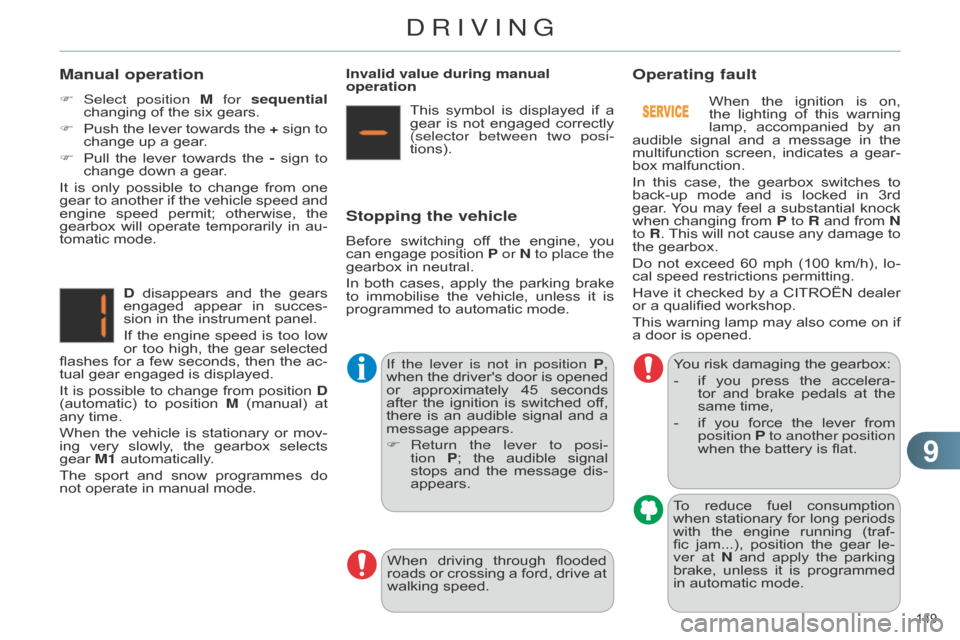
99
149
C4-2_en_Chap09_conduite_ed01-2014
Manual operation
F Select position M for sequential
changing of the six gears.
F
Push
the
lever
towards
the
+
sign
to
change
up a gear.
F
Pull
the
lever
towards
the
-
sign
to
change
down a gear.
It
is
only
possible
to
change
from
one
gear
to
another
if
the
vehicle
speed
and
engine
speed
permit;
otherwise,
the
gearbox
will
operate
temporarily
in
au
-
tomatic
mode.D
disappears
and
the
gears
engaged
appear
in
succes
-
sion
in the instrument panel.
If
the
engine
speed
is
too
low
or
too
high,
the
gear
selected
flashes
for
a
few
seconds,
then
the
ac
-
tual
gear engaged is displayed.
It
is
possible
to
change
from
position
D
(automatic)
to
position
M
(manual)
at
any
time.
When
the
vehicle
is
stationary
or
mov
-
ing
very
slowly
,
the
gearbox
selects
gear
M1 automatically.
The
sport
and
snow
programmes
do
not
operate in manual mode.Invalid value during manual
operation
This symbol is displayed if a
gear
is
not
engaged
correctly
(selector between two posi
-
tions).
Stopping the vehicle
Before switching of f the engine, you can
engage position P or N to place the
gearbox
in neutral.
In
both
cases,
apply
the
parking
brake
to
immobilise
the
vehicle,
unless
it
is
programmed
to automatic mode.
If the lever is not in position P,
when
the
driver's
door
is
opened
or
approximately
45
seconds
after
the
ignition
is
switched
of
f,
there
is
an
audible
signal
and
a
message
appears.
F
Return
the lever to posi-
tion
P
;
the
audible
signal
stops
and
the
message
dis
-
appears. You
risk damaging the gearbox:
-
if
you
press
the
accelera
-
tor
and
brake
pedals
at
the
same
time,
-
if
you
force
the
lever
from
position P
to another position
when
the battery is flat.
When
the
ignition
is
on,
the
lighting
of
this
warning
lamp,
accompanied
by
an
audible
signal
and
a
message
in
the
multifunction
screen,
indicates
a
gear
-
box malfunction.
In
this
case,
the
gearbox
switches
to
back-up
mode
and
is
locked
in
3rd
gear
.
Y
ou
may
feel
a
substantial
knock
when
changing
from
P
to R
and
from
N
to R. This will not cause any damage to the
gearbox.
Do
not
exceed
60
mph
(100
km/h),
lo
-
cal
speed restrictions permitting.
Have
it
checked
by
a
CITROËN
dealer
or
a qualified workshop.
This
warning
lamp
may
also
come
on
if
a
door is opened.
Operating fault
To reduce fuel consumption when
stationary for long periods
with
the
engine
running
(traf
-
fic
jam...),
position
the
gear
le
-
ver at
N
and
apply
the
parking
brake,
unless
it
is
programmed
in
automatic mode.
When
driving
through
flooded
roads
or
crossing
a
ford,
drive
at
walking
speed.
DRIVING
Page 153 of 340
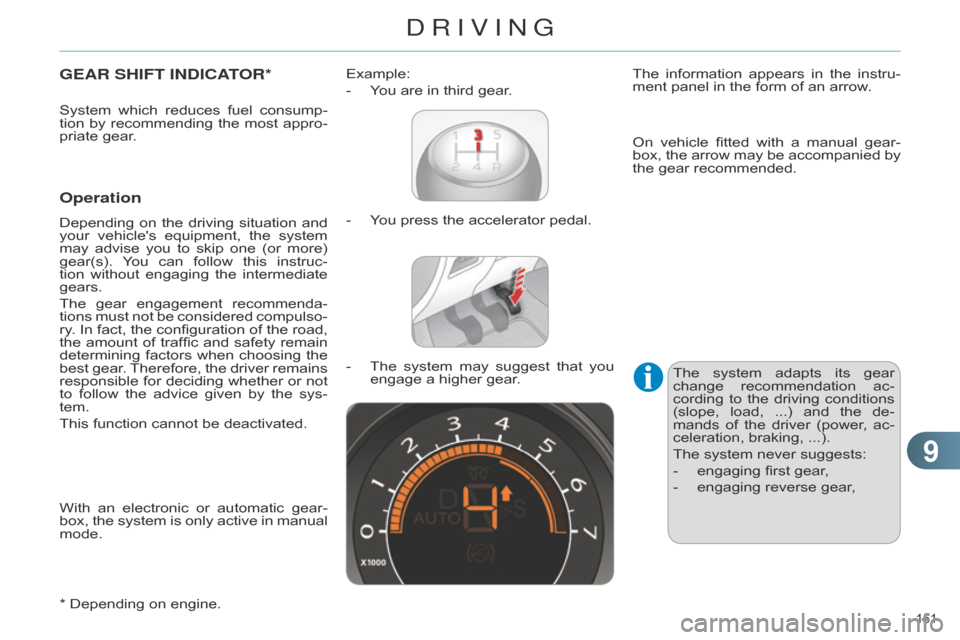
99
151
C4-2_en_Chap09_conduite_ed01-2014
GEAR SHIFT INDICATOR*
Operation
Depending on the driving situation and your
vehicle's equipment, the system
may
advise
you
to
skip
one
(or
more)
gear(s).
Y
ou
can
follow
this
instruc
-
tion
without
engaging
the
intermediate
gears.
The
gear
engagement
recommenda
-
tions
must
not
be
considered
compulso
-
ry.
In
fact,
the
configuration
of
the
road,
the
amount
of
traffic
and
safety
remain
determining
factors
when
choosing
the
best
gear
.
Therefore,
the
driver
remains
responsible
for
deciding
whether
or
not
to
follow
the
advice
given
by
the
sys
-
tem.
This
function cannot be deactivated.-
Y ou press the accelerator pedal.
Example:
-
Y
ou are in third gear.
-
The
system
may
suggest
that
you
engage
a higher gear.The
information
appears
in
the
instru
-
ment panel in the form of an arrow.
The
system
adapts
its
gear
change
recommendation
ac
-
cording
to
the
driving
conditions
(slope,
load,
...)
and
the
de
-
mands
of
the
driver
(power
,
ac
-
celeration,
braking, ...).
The
system never suggests:
-
engaging
first gear,
-
engaging
reverse gear,
System
which
reduces
fuel
consump
-
tion
by
recommending
the
most
appro
-
priate gear.
With
an
electronic
or
automatic
gear
-
box,
the
system
is
only
active
in
manual
mode.
*
Depending on engine. On
vehicle
fitted
with
a
manual
gear
-
box,
the
arrow
may
be
accompanied
by
the
gear recommended.
DRIVING
Page 156 of 340
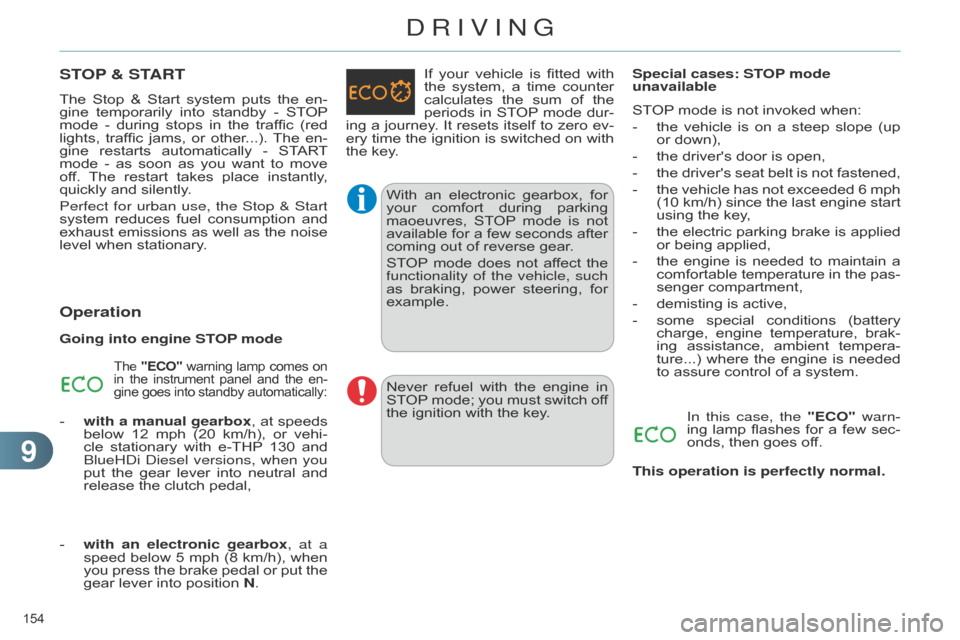
99
154
C4-2_en_Chap09_conduite_ed01-2014
STOP & START
The Stop & Start system puts the en -
gine temporarily into standby - ST OP mode
-
during
stops
in
the
traffic
(red
lights,
traffic
jams,
or
other
...).
The
en
-
gine
restarts
automatically
-
ST
ART
mode
-
as
soon
as
you
want
to
move
of
f.
The
restart
takes
place
instantly
,
quickly
and silently.
Perfect for urban use, the Stop & Start
system
reduces
fuel
consumption
and
exhaust
emissions
as
well
as
the
noise
level
when stationary.
Operation
Going into engine STOP mode
The "ECO" warning lamp comes on in
the instrument panel and the en -
gine
goes into standby automatically:
- with a manual gearbox, at speeds below
12 mph (20 km/h), or vehi -
cle
stationary
with
e-THP 130
and
b
lueH d i
d
iesel versions, when you
put
the
gear
lever
into
neutral
and
release
the clutch pedal, If
your
vehicle
is
fitted
with
the
system,
a
time
counter
calculates
the
sum
of
the
periods
in
ST
OP
mode
dur
-
ing
a
journey
.
It
resets
itself
to
zero
ev
-
ery
time
the
ignition
is
switched
on
with
the
key.
-
with
an electronic gearbox, at a
speed
below
5
mph
(8
km/h),
when
you
press
the
brake
pedal
or
put
the
gear
lever into position N.With
an
electronic
gearbox,
for
your
comfort
during
parking
maoeuvres,
ST
OP
mode
is
not
available
for
a
few
seconds
after
coming
out of reverse gear.
STOP
mode
does
not
af
fect
the
functionality of the vehicle, such
as
braking,
power
steering,
for
example.Special cases: ST
OP mode
unavailable
STOP
mode is not invoked when:
-
the
vehicle
is
on
a
steep
slope
(up
or
down),
-
the
driver's door is open,
-
the
driver's
seat
belt
is
not
fastened,
-
the
vehicle
has
not
exceeded
6
mph
(10
km/h)
since
the
last
engine
start
using
the key,
-
the
electric
parking
brake
is
applied
or
being applied,
-
the
engine
is
needed
to
maintain
a
comfortable
temperature
in
the
pas
-
senger compartment,
-
demisting
is active,
-
some
special
conditions
(battery
charge,
engine
temperature,
brak
-
ing
assistance,
ambient
tempera
-
ture...)
where
the
engine
is
needed
to
assure control of a system.
In this case, the "ECO" warn-
ing lamp flashes for a few sec -
onds,
then goes off.
Never
refuel
with
the
engine
in
ST
OP
mode;
you
must
switch
of
f the
ignition with the key.
This operation is perfectly normal.
DRIVING
Page 157 of 340
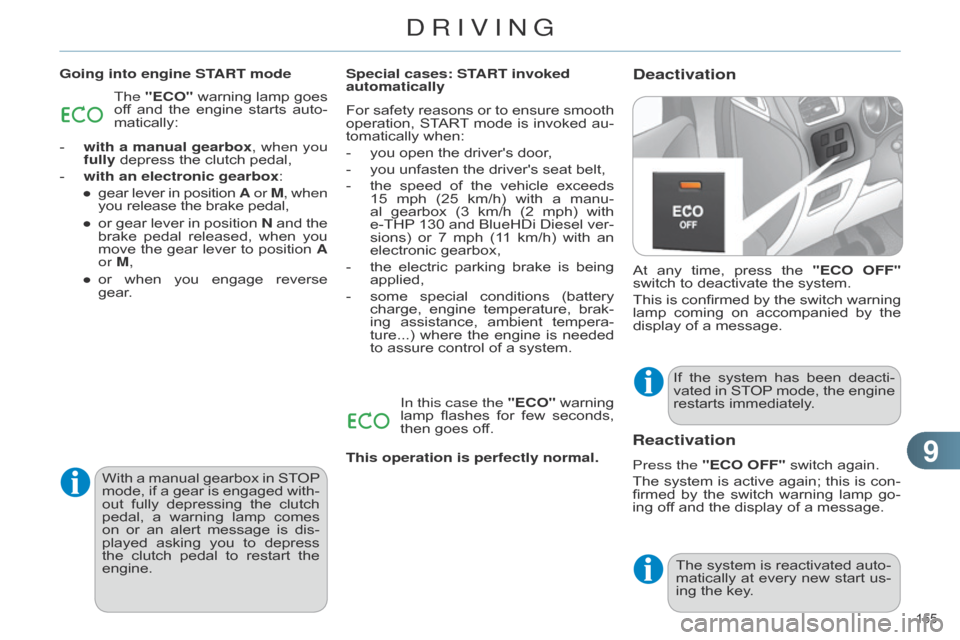
99
155
C4-2_en_Chap09_conduite_ed01-2014
DeactivationGoing into engine START modeAt
any
time,
press
the
"ECO OFF"
switch
to deactivate the system.
This
is
confirmed
by
the
switch
warning
lamp
coming
on
accompanied
by
the
display
of a message.
Special cases: START invoked
automatically
If
the
system
has
been
deacti
-
vated
in
ST
OP
mode,
the
engine
restarts
immediately.
The
"ECO"
warning
lamp
goes
of
f
and
the
engine
starts
auto
-
matically:
-
with a manual gearbox
, when you
fully
depress the clutch pedal,
-
with an electronic gearbox
:
●
gear
lever
in
position
A or
M, when
you
release the brake pedal,
●
or
gear
lever
in
position
N
and
the
brake
pedal
released,
when
you
move
the
gear
lever
to
position
A
or M,
●
or
when
you
engage
reverse
gear
. For
safety
reasons
or
to
ensure
smooth
operation,
ST
ART
mode
is
invoked
au
-
tomatically
when:
-
you
open the driver's door,
-
you
unfasten the driver's seat belt,
-
the
speed
of
the
vehicle
exceeds
15
mph
(25
km/h)
with
a
manu
-
al
gearbox
(3
km/h
(2
mph)
with
e-THP 130
and
BlueHDi
Diesel
ver
-
sions)
or
7
mph
(1
1
km/h)
with
an
electronic
gearbox,
-
the
electric
parking
brake
is
being
applied,
-
some
special
conditions
(battery
charge,
engine
temperature,
brak
-
ing
assistance,
ambient
tempera
-
ture...)
where
the
engine
is
needed
to
assure control of a system.
In this case the "ECO"
warning
lamp
flashes
for
few
seconds,
then
goes off.
With
a
manual
gearbox
in
ST
OP
mode,
if
a
gear
is
engaged
with
-
out
fully
depressing
the
clutch
pedal,
a
warning
lamp
comes
on
or
an
alert
message
is
dis
-
played
asking
you
to
depress
the
clutch
pedal
to
restart
the
engine.
Reactivation
Press the "ECO OFF" switch again.
The
system
is
active
again;
this
is
con
-
firmed
by
the
switch
warning
lamp
go
-
ing
off and the display of a message.
The
system
is
reactivated
auto
-
matically
at
every
new
start
us
-
ing
the key.
This operation is perfectly normal.
DRIVING
Page 158 of 340
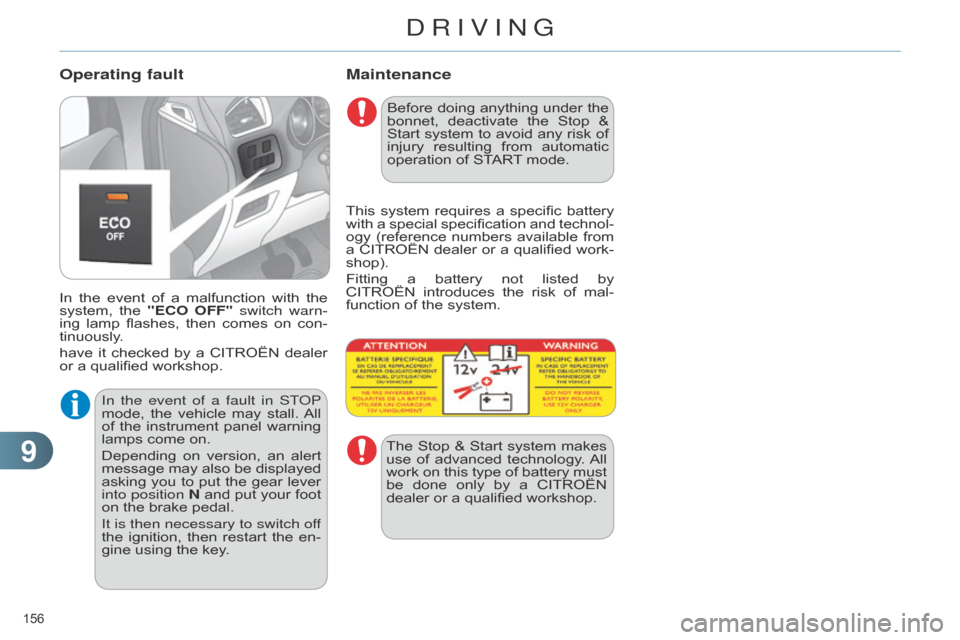
99
156
C4-2_en_Chap09_conduite_ed01-2014
Maintenance
In the event of a malfunction with the system,
the "ECO OFF" switch warn-
ing
lamp
flashes,
then
comes
on
con
-
tinuously.
have
it
checked
by
a
CITROËN
dealer
or
a qualified workshop.
Operating fault
Before doing anything under the bonnet,
deactivate the Stop &
Start
system
to
avoid
any
risk
of
injury
resulting
from
automatic
operation
of START
mode.
This
system
requires
a
specific
battery
with
a
special
specification
and
technol
-
ogy
(reference
numbers
available
from
a
CITROËN
dealer
or
a
qualified
work
-
shop).
Fitting
a
battery
not
listed
by
CITROËN
introduces
the
risk
of
mal
-
function
of the system.
The
Stop
&
Start
system
makes
use
of
advanced
technology
.
All
work
on
this
type
of
battery
must
be
done
only
by
a
CITROËN
dealer
or a qualified workshop.
In the event of a fault in ST
o
P
mode,
the
vehicle
may
stall.
All
of
the
instrument
panel
warning
lamps
come
on.
Depending
on
version,
an
alert
message
may
also
be
displayed
asking
you
to
put
the
gear
lever
into position
N
and
put
your
foot
on
the
brake
pedal.
It is then necessary to switch off
the
ignition,
then
restart
the
en
-
gine
using
the
key.
DRIVING
Page 166 of 340
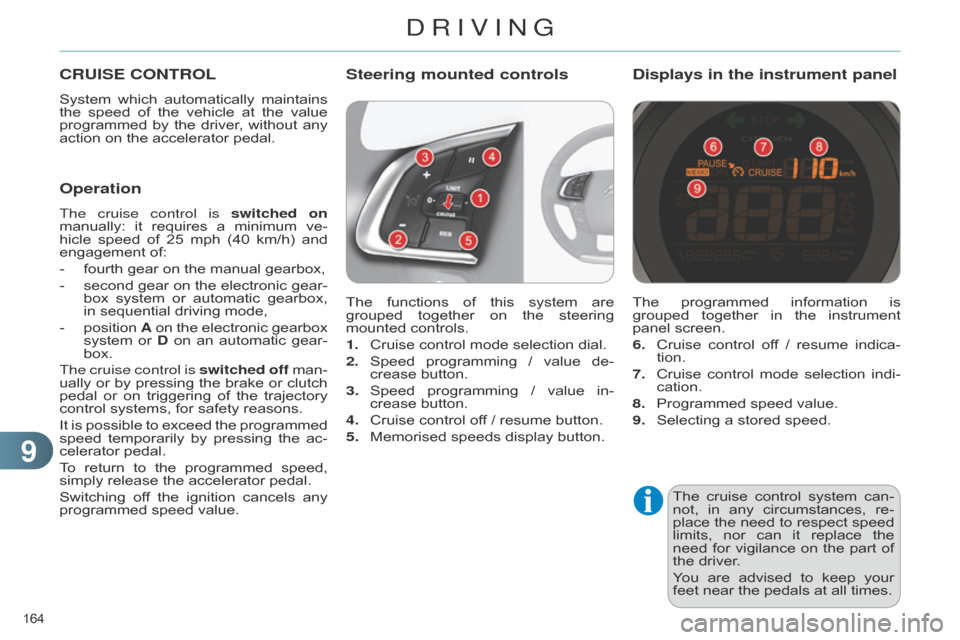
99
164
C4-2_en_Chap09_conduite_ed01-2014
The cruise control system can -
not, in any circumstances, re -
place
the
need
to
respect
speed
limits,
nor
can
it
replace
the
need
for
vigilance
on
the
part
of
the
driver.
You
are
advised
to
keep
your
feet
near the pedals at all times.
CRUISE CONTROL
System which automatically maintains the
speed of the vehicle at the value
programmed
by
the
driver
,
without
any
action
on the accelerator pedal.
The
functions
of
this
system
are
grouped
together
on
the
steering
mounted
controls.
1.
Cruise
control mode selection dial.
2.
Speed
programming
/
value
de
-
crease
button.
3.
Speed
programming
/
value
in
-
crease
button.
4.
Cruise
control off / resume button.
5.
Memorised
speeds display button.
Steering mounted controls
The programmed information is grouped
together in the instrument
panel
screen.
6.
Cruise
control
of
f
/
resume
indica
-
tion.
7.
Cruise
control
mode
selection
indi
-
cation.
8.
Programmed
speed value.
9.
Selecting
a stored speed.
Displays in the instrument panel
Operation
The cruise control is switched on
manually: it requires a minimum ve -
hicle
speed
of
25
mph
(40
km/h)
and
engagement
of:
-
fourth
gear on the manual gearbox,
-
second
gear
on
the
electronic
gear
-
box
system
or
automatic
gearbox,
in
sequential driving mode,
-
position
A
on
the
electronic
gearbox
system
or
D
on
an
automatic
gear
-
box.
The cruise control is switched off
man
-
ually
or
by
pressing
the
brake
or
clutch
pedal
or
on
triggering
of
the
trajectory
control
systems, for safety reasons.
It
is
possible
to
exceed
the
programmed
speed
temporarily
by
pressing
the
ac
-
celerator
pedal.
To
return
to
the
programmed
speed,
simply
release the accelerator pedal.
Switching
of
f
the
ignition
cancels
any
programmed
speed value.
DRIVING
Page 177 of 340

1010
175
C4-2_en_Chap10_verification_ed01-2014
BONNET
F Push the exterior safety catch B to
the left and raise the bonnet.
Opening
F Open the front left door.
F
Pull
the interior bonnet release le-
ver
A,
located
at
the
bottom
of
the
door
aperture. F
Unclip
the
stay
C
from
its
housing
on
the back of the bonnet.
F
Fix
the
stay
in
the
notch
to
hold
the
bonnet
open.
The location of the interior bonnet
release
lever
prevents
opening
of the
bonnet
while
the
front
left
door is
closed.
Closing
F Take the stay out of the support notch.
F
Clip
the
stay
in
its
housing
on
the
back
of the bonnet.
F
Lower
the
bonnet
and
release
it
at
the
end of its travel.
F
Pull
on
the
bonnet
to
check
that
it
is
secured
correctly.
Do
not
open
the
bonnet
in
high
winds.
When
the
engine
is
hot,
handle
the
exterior
safety
catch
and
the
bonnet
stay
with
care
(risk
of
burns).
Before
doing
anything
under
the
bonnet, switch of
f the Stop &
Start
system
to
avoid
any
risk
of
injury
resulting
from
an
automatic change
to
START
mode.
The cooling fan may start after
switching off the engine: take care
with articles and clothing that might
be caught by the fan blades.
b
ecause of the presence of
electrical
equipment
under
the
bonnet,
it
is
recommended
that
exposure
to
water
(rain,
washing,
...) be limited.
CHECKS
Page 217 of 340
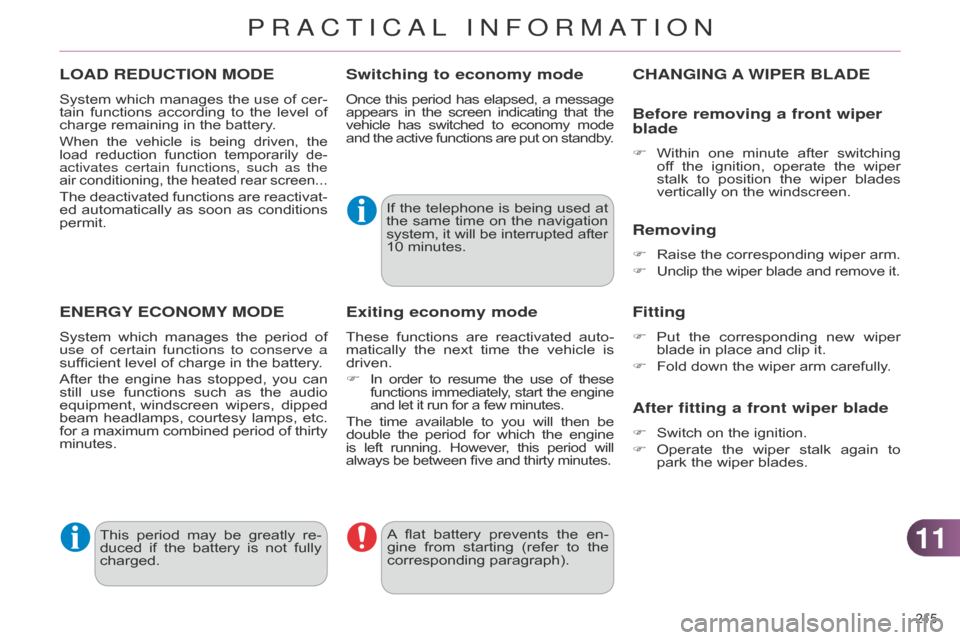
1111
215
C4-2_en_Chap11_info-pratique_ed01-2014
LOAD REDUCTION MODE
System which manages the use of cer -
tain functions according to the level of
charge
remaining in the battery.
When the vehicle is being driven, the load
reduction function temporarily de -
activates certain functions, such as the
air
conditioning,
the
heated
rear
screen...
The deactivated functions are reactivat -
ed automatically as soon as conditions
permit.
ENERGY ECONOMY MODE
System which manages the period of use of certain functions to conserve a
sufficient
level of charge in the battery.
After
the
engine
has
stopped,
you
can
still
use
functions
such
as
the
audio
equipment,
windscreen
wipers,
dipped
beam
headlamps,
courtesy
lamps,
etc.
for
a
maximum
combined
period
of
thirty minutes.
Switching to economy mode
Once this period has elapsed, a message appears
in the screen indicating that the vehicle
has
switched
to
economy
mode and
the
active
functions
are
put
on
standby
.
If the telephone is being used at the
same time on the navigation
system,
it
will
be
interrupted
after 10
minutes.
A
flat
battery
prevents
the
en
-
gine
from
starting
(refer
to
the
corresponding
paragraph).
Exiting economy mode
These functions are reactivated auto -
matically the next time the vehicle is
driven.
F
In
order
to
resume
the
use
of
these functions
immediately
,
start
the
engine and
let it run for a few minutes.
The
time
available
to
you
will
then
be double
the
period
for
which
the
engine is left running. However , this period will
always be between five and thirty minutes.
This period may be greatly re -
duced if the battery is not fully
charged.
CHANGING A WIPER BLADE
Before removing a front wiper
blade
F Within one minute after switching of
f the ignition, operate the wiper
stalk
to
position
the
wiper
blades
vertically
on the windscreen.
Removing
F Raise the corresponding wiper arm.
F
Unclip
the wiper blade and remove it.
Fitting
F Put the corresponding new wiper blade
in place and clip it.
F
Fold
down the wiper arm carefully.
After fitting a front wiper blade
F Switch on the ignition.
F
Operate
the
wiper
stalk
again
to
park
the wiper blades.
PRACTICAL INFORMATION